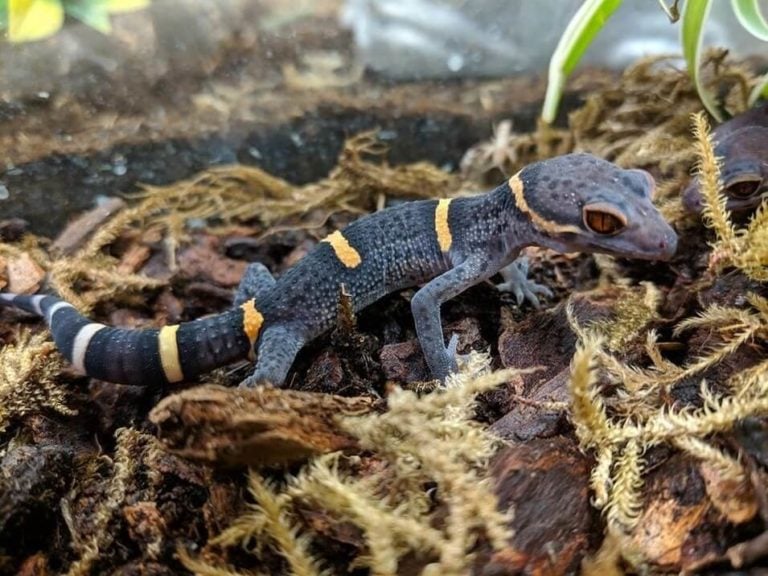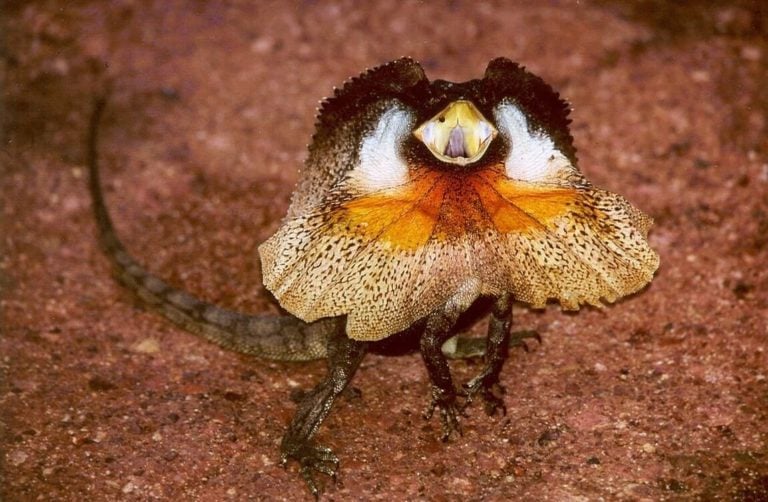Pacman frogs are easily one of our favorite species. These chinky little creatures are adorable, unique, and easy to care for.
As a result, these are one of the most popular species of frog to own (especially for beginners).
Because of this, we wanted to put together a comprehensive guide on how to take care of these critters the right way. There’s always a lot of misinformation about popular species, and we want to make sure new owners get the right advice.
This guide will teach you the core elements of Pacman frog care. You’ll learn about their diet, lifespan, tank setup, and much more!
Table of Contents
Species Summary
Pacman frogs (Ceratophrys ornata) are a popular species that is found in Brazil, Paraguay, Argentina, and Uruguay. Rainforests are their natural habitat where you’ll often find them partially buried in the dirt. This allows them to stay moist and ambush prey.
Because they’re so easy to care for (and breed), you’ll find these frogs in pet stores all over the world. This makes them a very approachable species for new herp owners.
Expert Tip: It’s important to point out that these frogs are not very active and don’t like being handled. Many new owners assume otherwise and are disappointed when they receive them.
Lifespan
The average Pacman frog lifespan is between 10 and 15 years. These amphibians can live quite long if given proper care!
However, it’s possible to shorten this lifespan significantly if you keep them in poor conditions. Don’t let their long lifespan trick you into thinking they’re more resilient than they are.
It’s important to factor this in when deciding if you want to purchase them or not. For such a beginner-friendly animal, this is quite a long time commitment!
Appearance & Colors
The appearance of the Pacman frog plays a big part in the popularity of the species. These stout critters are almost funny to look at. They’re just so round!
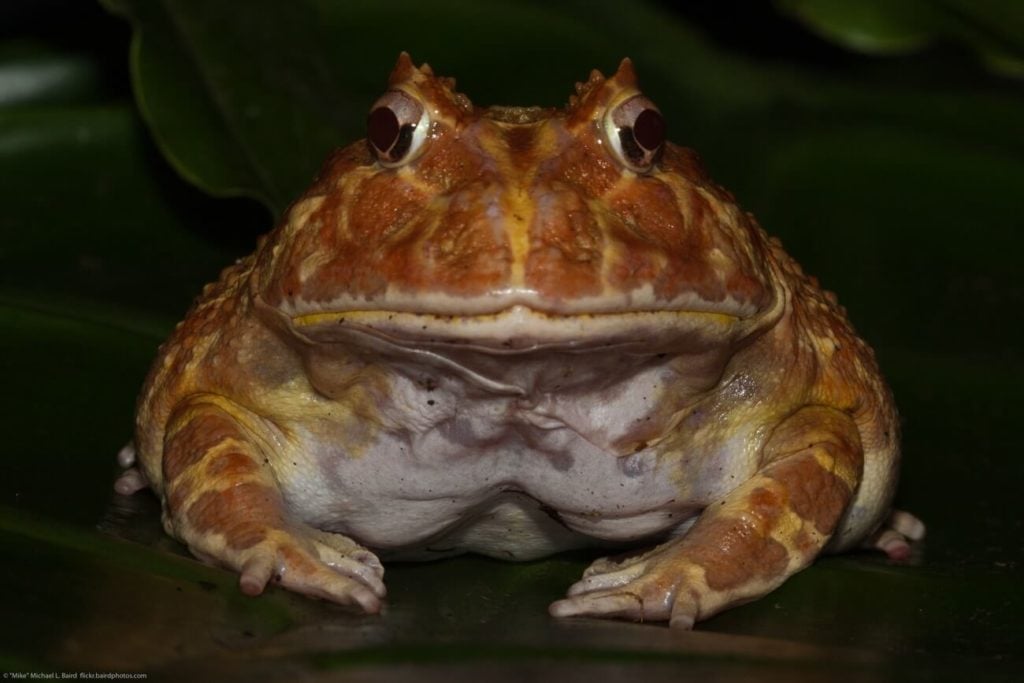
These frogs have a very large mouth (hence the name) that fits with their rather big heads. While this might look funky at first, it makes them great hunters and allows them to eat a wide range of different foods.
The rest of their body is pretty standard for frogs. It’s just wider. Their midsection is quite round and they have thick, chunky arms.
As you can tell from their body type, Pacman frogs are not creatures made for high-flying acrobatics. They prefer to dig, wait, and eat.
This species comes in a number of different colors. There’s brown (chocolate), albino, yellow, and green. Specimens with green primary coloring will either have red and brown patches on their body, or brown ones.
The long patches on their body are a design that’s fairly consistent no matter what the main color is. While the placement might be a little bit different on each frog, the overall pattern is the same.
Average Size
The average size of a Pacman frog varies by gender. Males are usually between 2.5 and 4 inches in length, and females typically end up in the 4 to 7 inch range.
This means there’s the possibility to have vastly different sizes depending on the specimen and gender. Just think, a large 7 inch female is a totally different beast than a small 2.5 inch male!
Expert Tip: Pacman frog sizes can be influenced by a number of different factors. Breeding methods, genetics, and care during developmental years tend to make the biggest impact.
Pacman Frog Care
Pacman frog care is a very simple and straightforward process. These creatures don’t require a complicated care regimen, making them a great choice for beginners (or experts who want to keep a low-maintenance species).
But just because they’re beginner-friendly doesn’t mean you should be lazy.
Your goal as an owner should always be to maximize the health and happiness of your Pacman frogs, so aim to provide perfect care whenever possible.
Tank Size/Dimensions
The recommended tank size for a Pacman frog is at least 10 gallons. This is assuming you’re keeping just one frog, which is a good idea (more on that later).
Their activity level and temperament is the reason why you can keep these frogs in a rather small tank. They’ll spend a lot of time semi-buried in the substrate and won’t move around that much.
With that being said, a 20-gallon tank is always better. That extra space will allow you to create a more comfortable habitat that will feel natural to them.
Tank Setup
The first and most important thing to think about is the substrate. Since Pacman frogs like to burrow, it’s essential for them to have a substrate that facilitates this.
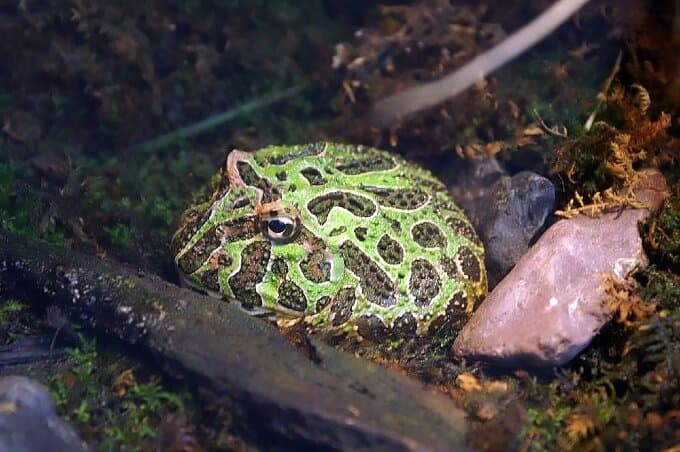
Some rich soil that mimics their natural rainforest environment is ideal. This will hold moisture and allow them to dig easily. You can also use a ground coconut soil mix as well. You’ll want the substrate to be at least a few inches thick so they can dig without hitting the bottom.
Expert Tip: Make sure to mist the substrate a bit each day. This will allow your Pacman frogs to be comfortable (and not too dry) and also help regulate humidity in their enclosure.
Including some plants in their habitat is a good idea as well. This will help mimic their natural environment and help them feel safe.
Avoid any plants that are prickly or sharp. Pacman frogs can get cut very easily, so keep this in mind when deciding on vegetation. Something soft that provides some fairly dense cover will do great.
Temperature & Lighting
The ideal temperature in their habitat should be somewhere between 75°F and 85°F. Aim for the middle if possible.
This will mimic their natural environment and allows them to feel quite comfortable. Pacman frogs will actually be a little bit cooler than this since they spend most of their time buried in the moist substrate.
While some care sheets will recommend an even lower temperature range, we tend to avoid that. Even though it can work, the most successful Pacman owners we’ve met all stick within the 75°F to 85°F range.
As far as lighting goes, they Pacman frogs have very straightforward requirements. Aim to give them 12 hours of light each day (this is easy to make work with your schedule).
You don’t need to worry about UVB lighting for this species. In their natural habitat, these creatures don’t get much UVB light at all!
Expert Tip: We’ve seen some people on forums talking about the possibility of keeping Pacman frogs with very minimal lighting. This is absolutely not viable. It’s very important to keep them on a 12 hour per day schedule.
Water & Humidity
In general, you want to aim for around 60% humidity in the tank. This will replicate their natural environment and allow them to feel comfortable in the substrate.
The moisture of the substrate and humidity in their enclosure are closely related. If the substrate is too dry, it will be tough to maintain the overall humidity. But if the overall humidity is low, then the substrate will likely dry out as well.
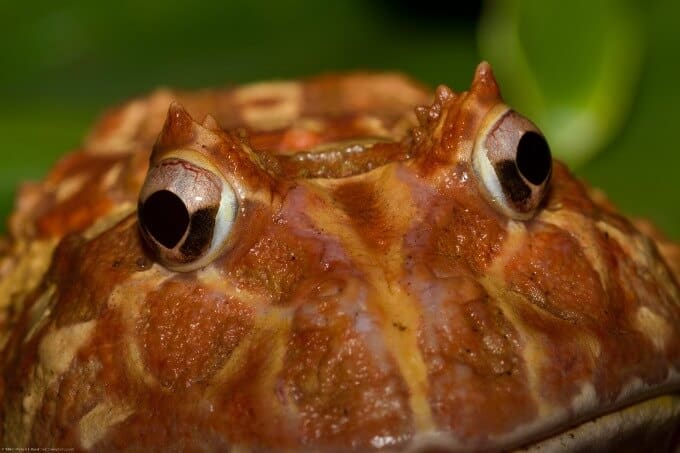
This is why we recommend misting the substrate on a daily basis. You don’t want to douse it in water, just give it enough to keep things relatively moist. This will keep them comfortable, and make it far easier to manage the humidity in the tank.
You’ll also want to give your Pacman frogs a water dish. This bowl should be on the shallow side since these creatures aren’t great swimmers.
This bowl will be where they go to have a drink and splash around a bit (keeping their skin nice and hydrated). It’s a very important part of their habitat, so make sure to get something suitable.
Expert Tip: This is why keeping them in a slightly larger tank is a good idea. It will give you enough room to have a large, shallow water bowl and plenty of room for them to burrow.
Diet & Food
The ideal Pacman frog diet contains a lot of different foods. These creatures are far from picky!
In the wild, they eat a variety of insects, fish, and mice! When they’re babies you should stick to manageable insects like crickets, wax worms, and mealworms.
As they get larger you can start to add in phoenix worm, roaches, horned works, and earthworms. All of these insects should serve as the staple of their diet, which is great because they’re fairly convenient.
These foods also make it easy when doing calcium supplementation. You can easily dust them with a powder and toss them in!
If you feel like dabbling with mice you’ll need to feed your younger (and smaller) Pacman frogs newborn mice. Larger mice will be too big for them to handle! You can work your way up when your frogs get bigger.
Potential Health Issues
While Pacman frogs are fairly durable animals, there are a few potential health issues you’ll need to keep an eye out for.
Like many frogs, the skin of this species is very important. Their skin needs to be well-hydrated and can end up becoming infected in subpar conditions.
Whether it be by fungus or bacteria, an infection of the skin is something you want to avoid. It’s quite uncomfortable for the frogs and can cause serious health complications if not addressed promptly.
Pacman frogs can have issues with parasites as well. This will result in lethargy and a lack of appetite.
Keeping these frogs in an environment that’s too dry can lead to respiratory issues as well. These creatures are not built to handle dry air and can become quite sick as a result.
Behavior & Temperament
For the most part, Pacman frogs are a very mellow species. They’ll spend most of their time either buried in the substrate or venturing to their water bowl to get a drink (and splash around).
As your frog becomes more comfortable in their new home, you’ll likely notice a bit more activity from them. This is all relative of course, but expect them to be pretty much hunkered down for the first few days.
Handling Them
Handling your Pacman frog is something you should ease your way into. While these creatures are generally quite peaceful, they need some time to get used to being touched.
And with that being said, it’s still not something you’ll want to do often.
This species prefers to be safely tucked away in the dirt. While they’ll grow to become more tolerant of handling over time, there’s a limit to how much they really want.
If you pick them up too often there’s a good chance they’ll get anxious, stressed, and potentially angry. Pacman frogs have little teeth and are more than capable of biting, so if you go too far they might let you know!
Because of this, keep handling to a minimum and learn to respect the signs of your pet frog. You’ll learn to recognize when they’re not in the mood.
Expert Tip: Regardless, it’s always a good idea to practice smart frog handling. Keep them close to a surface so they can’t fall if they slip out of your hands, and don’t squeeze them too tightly.
Ready To Get One?
As you can see, Pacman frog care is something anyone can handle. These creatures are low-maintenance, easygoing, and require a very standard tank setup.
Owning one of these wide-bodied frogs is quite fun. You’d be surprised how entertaining it is to watch them burrow into the substrate!
If there’s still more you’d like to learn about Pacman frogs before you pick one up for yourself just give us a shout. Preparing yourself as much as you can before buying a pet is the mark of a responsible owner, and we’re more than happy to help!

